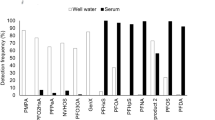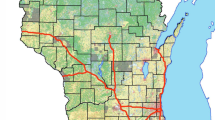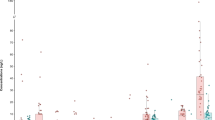Abstract
Introduction
Per and polyfluoroalkyl substances (PFAS), including perfluorononanoic acid (PFNA) and perfluorooctanoic acid (PFOA), were detected in the community water supply of Paulsboro New Jersey in 2009.
Methods
A cross-sectional study enrolled 192 claimants from a class-action lawsuit, not affiliated with this study, who had been awarded a blood test for 13 PFAS. Study participants provided their blood test results and completed a survey about demographics; 105 participants also completed a health survey. Geometric means, 25th, 50th, 75th, and 95th percentiles of exposure of PFNA blood serum concentrations were compared to that of the 2013–2014 NHANES, adjusted for reporting level. Associations between PFNA, PFOA, PFOS, and PFHxS and self-reported health outcomes were assessed using logistic regression.
Results
PFNA serum levels were 285% higher in Paulsboro compared with U.S. residents. PFNA serum levels were higher among older compared with younger, and male compared to female, Paulsboro residents. After adjustment for potential confounding, there was a significant association between increased serum PFNA levels and self-reported high cholesterol (OR: 1.15, 95% CI: 1.02, 1.29).
Discussion/Conclusion
Further investigation into possible health effects of PFAS exposure in Paulsboro and other community settings is warranted. Since exposure has ceased, toxicokinetics of PFAS elimination should be explored.
This is a preview of subscription content, access via your institution
Access options
Subscribe to this journal
Receive 6 print issues and online access
$259.00 per year
only $43.17 per issue
Buy this article
- Purchase on Springer Link
- Instant access to full article PDF
Prices may be subject to local taxes which are calculated during checkout
Similar content being viewed by others
References
Bartolome M, Gallego-Pico A, Cutanda F, Huetos O, Esteban M, Perez-Gomez B, et al. Perfluorinated alkyl substances in Spanish adults: geographical distribution and determinants of exposure. Sci Total Environ. 2017;603–604:352–60.
Hu XC, Andrews DQ, Lindstrom AB, Bruton TA, Schaider LA, Grandjean P, et al. Detection of poly- and perfluoroalkyl substances (PFASs) in U.S. drinking water linked to industrial sites, military fire training areas, and wastewater treatment plants. Environ Sci Technol Lett. 2016;3:344–50.
Oakes KD, Benskin JP, Martin JW, Ings JS, Heinrichs JY, Dixon DG, et al. Biomonitoring of perfluorochemicals and toxicity to the downstream fish community of Etobicoke Creek following deployment of aqueous film-forming foam. Aquat Toxicol. 2010;98:120–9.
Rappazzo KM, Coffman E, Hines EP. Exposure to perfluorinated alkyl substances and health outcomes in children: a systematic review of the epidemiologic literature. Int J Environ Res Public Health. 2017;691:1–22. https://doi.org/10.3390/ijerph14070691
Dobraca D, Israel L, McNeel S, Voss R, Wang M, Gajek R, et al. Biomonitoring in California firefighters: metals and perfluorinated chemicals. J Occup Environ Med / Am Coll Occup Environ Med. 2015;57:88–97.
Lindstrom AB, Strynar MJ, Libelo EL. Polyfluorinated compounds: past, present, and future. Environ Sci Technol. 2011;45:7954–61.
Zhao Z, Xie Z, Moller A, Sturm R, Tang J, Zhang G, et al. Distribution and long-range transport of polyfluoroalkyl substances in the Arctic, Atlantic Ocean and Antarctic coast. Environ Pollut. 2012;170:71–7.
Kato K, Wong LY, Jia LT, Kuklenyik Z, Calafat AM. Trends in exposure to polyfluoroalkyl chemicals in the U.S. Population: 1999-2008. Environ Sci Technol. 2011;45:8037–45.
US Environmental Protection Agency (EPA). PFAS laws and regulations. 2018. https://www.epa.gov/pfas/pfas-laws-and-regulations. June 6, 2018.
Official Journal of the European Union. Commission Regulation (EU) 2017/1000 of 13 June 2017 amending Annex XVII to Regulation (EC) No 1907/2006 of the European Parliament and of the Council concerning the Registration, Evaluation, Authorisation and Restriction of Chemicals (REACH) as regards perfluorooctanoic acid (PFOA), its salts and PFOA-related substances. https://eur-lex.europa.eu/legal-content/EN/TXT/PDF/?uri=CELEX:32017R1000&from=EN. June 17, 2018.
International Agency on Cancer Research. List of classifications by cancer sites with sufficient or limited evidence in humans, vol. 1–114. 2015. http://monographs.iarc.fr/ENG/Classification/Table4.pdf. March 19, 2018.
Post GB, Louis JB, Lippincott RL, Procopio NA. Occurrence of perfluorinated compounds in raw water from New Jersey public drinking water systems. Environ Sci Technol. 2013;47:13266–75.
Federal and NJ State Primary and Secondary Drinking Water Standards as of September 2018. https://www.state.nj.us/dep/watersupply/pdf/dw-standards.pdf. Accessed on: Oct 28, 2018
Lopez-Espinosa MJ, Mondal D, Armstrong BG, Eskenazi B, Fletcher T. Perfluoroalkyl substances, sex hormones, and insulin-like growth factor-1 at 6–9 years of age: a cross-sectional analysis within the C8 Health Project. Environ Health Perspect. 2016;124:1269–75.
Nelson JW, Hatch EE, Webster TF. Exposure to polyfluoroalkyl chemicals and cholesterol, body weight, and insulin resistance in the general U.S. population. Environ Health Perspect. 2010;118:197–202.
Salihovic S, Stubleski J, Karrman A, Larsson A, Fall T, Lind L, et al. Changes in markers of liver function in relation to changes in perfluoroalkyl substances—a longitudinal study. Environ Int. 2018;117:196–203.
Lind PM, Salihovic S, van Bavel B, Lind L. Circulating levels of perfluoroalkyl substances (PFASs) and carotid artery atherosclerosis. Environ Res. 2017;152:157–64.
Kielsen K, Shamim Z, Ryder LP, Nielsen F, Grandjean P, Budtz-Jorgensen E, et al. Antibody response to booster vaccination with tetanus and diphtheria in adults exposed to perfluorinated alkylates. J Immunotoxicol. 2016;13:270–3.
DeNavas-Walt CPBD. Income and poverty in the United States: 2014. Report Number P60-252. 2015. https://www.census.gov/library/publications/2015/demo/p60-252.html. October 30, 2018.
US Centers for Disease Control and Prevention (CDC). Laboratory procedure manual.https://wwwn.cdc.gov/nchs/data/nhanes/2013-2014/labmethods/PFAS_H_MET.pdf. 2015.
USDHHS. Centers fo Disease Control and Prevention. About the National Health and Nutrition Examination Survey (NHANES). 2018. https://www.cdc.gov/nchs/nhanes/about_nhanes.htm. June 2, 2018.
US Census Bureau. American fact finder. 2014. https://factfinder.census.gov/faces/tableservices/jsf/pages/productview.xhtml?src=CF. July 16, 2018.
Lee SE, FRN. Analyzing Complex Survey Data: Thousand Oaks CA USA. Sage Publications Inc. 2005;71.
Singer AB, Whitworth KW, Haug LS, Sabaredzovic A, Impinen A, Papadopoulou E, et al. Menstrual cycle characteristics as determinants of plasma concentrations of perfluoroalkyl substances (PFASs) in the Norwegian Mother and Child Cohort (MoBa study). Environ Res. 2018;166:78–85.
Rush EL, Singer AB, Longnecker MP, Haug LS, Sabaredzovic A, Symanski E, et al. Oral contraceptive use as a determinant of plasma concentrations of perfluoroalkyl substances among women in the Norwegian Mother and Child Cohort (MoBa) study. Environ Int. 2018;112:156–64.
Manzano-Salgado CB, Casas M, Lopez-Espinosa MJ, Ballester F, Martinez D, Ibarluzea J, et al. Variability of perfluoroalkyl substance concentrations in pregnant women by socio-demographic and dietary factors in a Spanish birth cohort. Environ Int. 2016;92-93:357–65.
Olsen GW, Burris JM, Ehresman DJ, Froehlich JW, Seacat AM, Butenhoff JL, et al. Half-life of serum elimination of perfluorooctanesulfonate,perfluorohexanesulfonate, and perfluorooctanoate in retired fluorochemical production workers. Environ Health Perspect. 2007;115:1298–305.
Li Y, Fletcher T, Mucs D, Scott K, Lindh CH, Tallving P, et al. Half-lives of PFOS, PFHxS and PFOA after end of exposure to contaminated drinking water. Occup Environ Med. 2018;75:46–51.
Zhang Y, Beesoon S, Zhu L, Martin JW. Biomonitoring of perfluoroalkyl acids in human urine and estimates of biological half-life. Environ Sci Technol. 2013;47:10619–27.
US Department of Health and Human Servcies, Agency for Toxic Substances and Disease Registry (ATSDR). Toxicological profile for perfluoroalkyls draft for public comment. 2018.
Fu Y, Wang T, Fu Q, Wang P, Lu Y. Associations between serum concentrations of perfluoroalkyl acids and serum lipid levels in a Chinese population. Ecotoxicol Environ Saf. 2014;106:246–52.
Centers for Disease Control and Prevetion. Behavioral Risk Factor Surveillance System (BRFSS). http://www.cdc.gov/BRFSS/. 2018
Schecter A, Malik-Bass N, Calafat AM, Kato K, Colacino JA, Gent TL, et al. Polyfluoroalkyl compounds in Texas children from birth through 12 years of age. Environ Health Perspect. 2012;120:590–4.
Ye X, Kato K, Wong LY, Jia T, Kalathil A, Latremouille J, et al. Per- and polyfluoroalkyl substances in sera from children 3–11 years of age participating in the National Health and Nutrition Examination Survey 2013-2014. Int J Hyg Environ Health. 2018;221:9–16.
Centers for Disease Control and Prevetion, National Center for Environmental Health, Agency for Toxic Substances and Disease Register. An overview of perfluoroalkyl and polyfluoroalkyl substances and interim guidance for clinicians responding to patient exposure concerns. 2017. https://www.atsdr.cdc.gov/pfc/docs/pfas_clinician_fact_sheet_508.pdf. June 25, 2018.
Acknowledgements
This work was funded by the Rutgers Center for Environmental Exposure and Disease (CEED) pilot grant program NIEHS Center grant project number 5P30ES005022–29. We would like to thank the many people who made this project possible, including current and former residents of Paulsboro NJ who participated in this study, as well as: Kerry Butch of the CEED Community Outreach and Engagement Core, Brian Buckley PhD, Executive Director of Laboratories at EOHSI and the many EOHSI staff members and Rutgers SPH students who assisted with study implementation, including Shahnaz Alimokhtari, Omkar Bhawmik, Taylor Black, Clarimel Cepeda, Jennifer Gilman, Marta Hernandez, Prerna Malik, Amber Minnick, Alan Perez, Parita Ratnani, and Darsey Schulaka.
Author information
Authors and Affiliations
Corresponding author
Ethics declarations
Conflict of interest
The authors declare that they have no conflict of interest.
Electronic supplementary material
Rights and permissions
About this article
Cite this article
Graber, J.M., Alexander, C., Laumbach, R.J. et al. Per and polyfluoroalkyl substances (PFAS) blood levels after contamination of a community water supply and comparison with 2013–2014 NHANES. J Expo Sci Environ Epidemiol 29, 172–182 (2019). https://doi.org/10.1038/s41370-018-0096-z
Received:
Revised:
Accepted:
Published:
Issue Date:
DOI: https://doi.org/10.1038/s41370-018-0096-z
Keywords
This article is cited by
-
Biomonitoring of perfluoroalkyl and polyfluoroalkyl substances (PFAS) from the Survey of the Health of Wisconsin (SHOW) 2014–2016 and comparison with the National Health and Nutrition Examination Survey (NHANES)
Journal of Exposure Science & Environmental Epidemiology (2023)
-
Unwanted Ingredients—Highly Specific and Sensitive Method for the Extraction and Quantification of PFAS in Everyday Foods
Food Analytical Methods (2023)
-
Per- and polyfluoroalkyl substances exposure science: current knowledge, information needs, future directions
International Journal of Environmental Science and Technology (2022)
-
Evaluation and validation of methodologies for the extraction of per- and polyfluoroalkyl substances (PFASs) in serum of birds and mammals
Analytical and Bioanalytical Chemistry (2022)
-
Effects of Perfluorooctanoic Acid (PFOA) and Perfluorooctane Sulfonic Acid (PFOS) on Soil Microbial Community
Microbial Ecology (2022)



